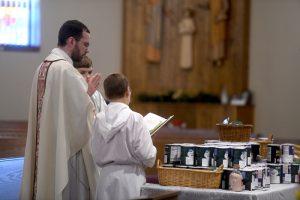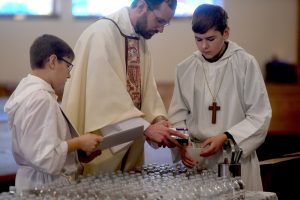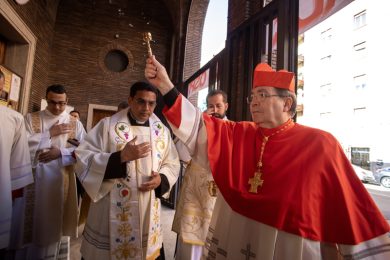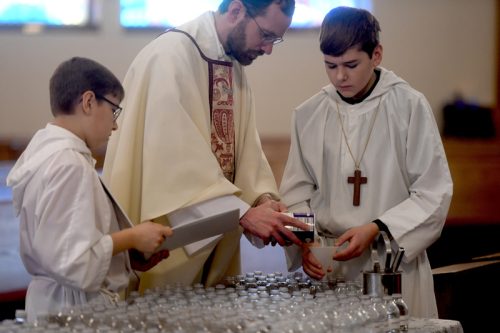Parishioners from the Four Pillars in Faith Area Catholic Community gathered at St. Mary Parish in Milaca Jan. 6 for a special Epiphany blessing of water, salt and chalk to take to bless their homes.
This long-held Catholic tradition symbolizes the commitment to welcome Christ into homes on a daily basis throughout the year.
Rita Olson, faith formation director for St. Mary’s and St. Louis Bertrand in Foreston, has always loved this tradition and wanted to revive it in the parishes she serves.

“The blessing is so powerful as it’s done only once a year on the Feast of the Epiphany,” Olson said. “There are so many graces associated with this blessing and it’s one that isn’t done in all parishes. I wanted our families to learn about it and benefit from it.”
The blessed water, salt and chalk are sacramentals. According to the materials handed out to parishioners, their power comes not from the objects themselves, but by means of the Church’s official prayer of blessing.
“When the blessed sacramentals are used with faith, people receive powerful graces and protection for themselves and their families,” Olson said.
Sacramentals make us more mindful, receptive and cooperative with God’s grace, the materials said. The blessing also is a reminder that Christ is the one who enlightens hearts and homes with his love.
“I have never attended a blessing like this before and it’s amazing,” said Tammy Krotzer. “The chalk and the Holy water have so much more meaning now that I have seen what goes into the blessing.”
 The formal blessing at St. Mary’s invited participation from the parishioners in attendance.
The formal blessing at St. Mary’s invited participation from the parishioners in attendance.
“I think it is nice having a more full rite as part of the blessing which includes a litany, psalms, the Magnificat, the Te Deum and chant,” said Father Timothy Gapinski, pastor of the Four Pillars in Faith Area Catholic Community, which includes the parishes in Milaca, Foreston, Ogilvie and Mora. “The rites of the Church are designed intentionally to help prepare those who participate in them to encounter God and the divine power.”

“To me, it was so powerful and so reverent,” said Chris Kotsmith, a member of the parish. “If we don’t have these weapons, the devil just has so much more power than we do and we don’t stand a chance.”
Kotsmith and his wife, Barb, planned to bring the blessed sacramentals to their adult children to bless their homes, too.
At home, the blessing involves taking the chalk and writing symbolic numbers and letters over the door, which, this year would look like this: 20+C+M+B+24.
The numbers represent the current year and the letters are the first letters of the traditional names of the magi: Caspar, Melchior and Balthazar. The letters are also an abbreviation for “Christus Mansionem Benedicat,” Latin for “May Christ bless this dwelling.”






















